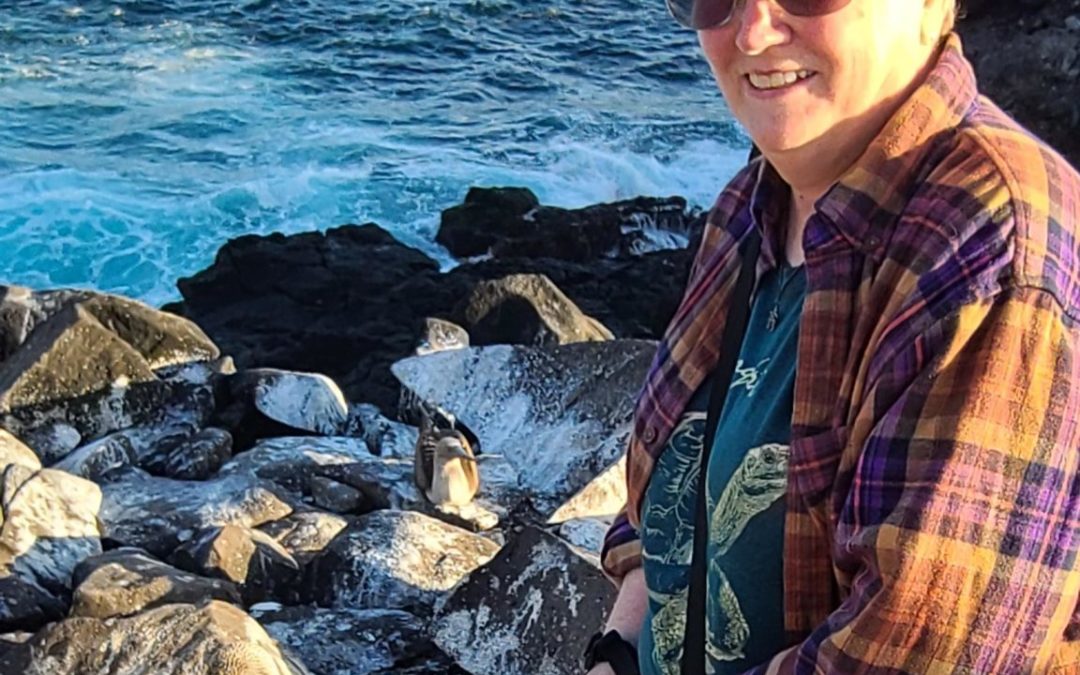Someone asked me what my goal for visiting the Galapagos was. At first, I didn’t know how to answer. The Galapagos is a bucket list trip for everyone, isn’t it? I’d known about the islands for decades, but it had never seemed possible to go before. It was so far from my everyday activities. A trip with veterinarians, Merry’s (A.K.A. Z) graduation, and severe cabin/COVID fever made the trip possible. Still, I was “so far down on the wait list” that there wasn’t much hope.
A year ago, I had conferred with Z, and then I added our names to the beyond the waitlist. Time passed, I forgot, and then a few days before Christmas I got an email with a two-day window to sign up. I called, confirmed with Z, and sent my deposit.
I still didn’t think the trip would happen. COVID was canceling lots of things still, and numbers were rising. Finally, at two weeks to go, I realized we were going.
“What do you really want to see?”
Ah, this is a question I could answer. “I want to see blue-footed boobies, marine iguanas and giant tortoises.”
“Well, those are reasonable. We should see all of those.” And we did. Lots of them.
The Blue-footed Booby is known for the brilliant blue feet that are used in the mating display. I wasn’t sure if the vivid baby-blue feet were a seasonal thing or all year. I was happy to see they are brilliant blue at maturity. The baby’s and juvenile’s feet are not brilliant, but they are more of a grey blue.
The blue color of Blue-footed Booby’s feet does vary in intensity. The boobies with bluer feet seem to have more success in finding a mate than birds with duller blue feet. Healthier chicks had dads with intensely blue feet. This could be because dad has the ability to keep himself well fed.
Booby is somewhat a stupid name and the target of many jokes, but the name is reportedly taken from the Spanish for “stupid” (“bobo”). The birds evolved without predators and are not afraid of people. The large birds would let you walk right up to them. The Spanish thought this tameness around people was stupid and hence the name. Also, the eyes face forward, and the long beak makes them look a tad foolish.
The birds are not stupid. They make a spectacular dive into the ocean from high in the air. The entire flock flew over us, and we were awestruck. Watching them pursue fish in the estuary with hundreds plunging into the water at any moment was breathtaking.
That wasn’t the best part. We were there at the height of the nesting/hatching season. Cool to see Blue-footed Boobies nest on islands. Beyond cool to see them with large cotton fluff ball babies. They don’t build a nest but lay eggs on bare ground. The incubating birds defecate while on the nest, and the eggs become surrounded by a circular wall of excrement. The males and females take turns feeding, and I was able to get a photo of a male returning to the nest to greet the female and two chicks. (The females are larger than the males.)
Turns out there are two other types of boobies in the Galapagos. The red-footed booby was also there. The body shape and size were similar, but they were variable in color. They were white with black flight feathers, entirely brown with paler brown heads, or brown with white tails. Galapagos white-morph adults have black tails, not white. All of the adults have pale bluish bills and both rosy and blue facial skin. Juveniles are sooty brown, but the babies were cotton fluff white. Of course, they had bright red feet.
Red-footed boobies had nests in the brush. The nests didn’t have a lot of work in them, but somehow they managed to hold an egg until the chick hatched. At least most of the time.
The last booby we saw was the Nazca booby. (Nazca is from the tectonic plate that moved to allow the Galapagos volcanic islands to form.) It is the largest of the three. They are white with black feathers on their tails. The males have yellow or orange beaks, while the female’s beak is far paler and has a more pinkish tone. They have gray feet and orange beaks.
Boobies have an average lifespan of 23 years. One of the major threats is abandoned fishing material (line, nets, and ghost nets) and plastics. These ocean pollution items get caught on necks, feet, and legs or are ingested because in the ocean it looks a lot like jellyfish. Ocean plastic was one of our continuing education lectures. It is estimated that plastics can take 450 years to break down. Even then it is breaking down to microparticles that can be found inside the bloodstream of humans and animals.
It is sad to think that this unique place is being threatened by everyday human activity right here at home.

